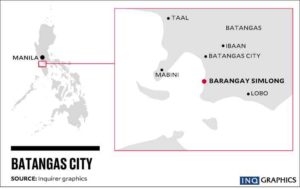
map Simlong
Three Chinese state-owned companies have agreed to develop a 102-hectare property into an energy complex in the coastal village of Simlong in Batangas City.
The memorandums of understanding (MOUs) for the $3-billion (P155.24-billion) investment in Batangas province were signed during President Rodrigo Duterte’s visit to Beijing last week.
The Philippines bagged $12 billion (P620.96 billion) worth of other trade deals, and industrial and infrastructure projects during the visit.
Simlong Energy Development Corp., which is named after the coastal village, signed the MOUs with China Gezhouba Group Co. Ltd. (CGGC), China Petroleum Pipeline Engineering Co. Ltd. (CPP) and the China Harbour Engineering Corp. (CHEC).
Energy Secretary Alfonso Cusi witnessed the event.
Three phases
Simlong Energy is an affiliate of Abacore Capital Holdings Inc., which Batangas Gov. Hermilando Mandanas helped establish in 1989. Mandanas’ wife, Regina Reyes, is one of Abacore’s directors.
In a telephone interview upon his return from Beijing on Tuesday, Mandanas said the project could be one of the biggest in the Philippines, making Batangas the country’s “de facto energy center.”
He said the project would generate local revenue and employment.
Land preparation would begin in June, paving the way for a project in three phases, which would be completed before Mr. Duterte’s term ends in 2022, Mandanas said.
CGGC, the same company tapped for the development of New Clark City in Tarlac, will undertake the land development and the construction of the power plants.
For export
The first phase is for the construction of a refinery for naphtha, a lightweight petrochemical commonly used as solvent in making cleaning fluids and varnish.
According to Mandanas, the existing naphtha cracker plant of the Gokongwei-led JG Summit Petrochemical Corp., which is also in Barangay Simlong, still imports the raw materials for its production.
He said the bulk of the naphtha production would be exported to China, Japan and Korea.
Favorable
The second phase involves the construction of an energy port for oil, natural gas and liquefied natural gas (LNG), and the final phase, the construction of a 1,560-megawatt power plant to energize the complex and supplement the national grid.
CPP is tapped for the construction of the refinery and storage tanks, and CHEC, for the port facilities, and oil and gas terminals.
“Under the new maritime laws for international shipping, vessels are now required to shift to LNG (from) diesel or bunker for fuel for environmental reasons. In Asia, only Singapore, Japan, Korea have LNG fuel facilities,” Mandanas said.
Batangas, which hosts an international shipping port, is “geographically favorable” for an LNG port, the governor said. —Maricar Cinco

